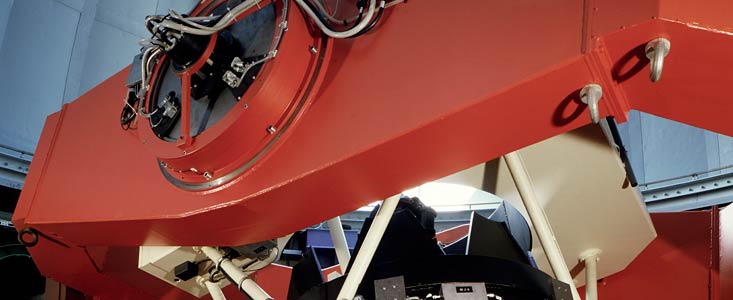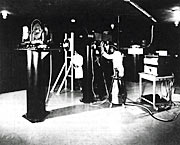Press Release
Is the Universe Younger than Previously Thought?
3 July 1987
The first observations of a long-lived radioactive isotope outside the Solar System indicate that the Universe may be younger than previously thought. Using one of the world's most powerful spectrometers, located at the ESO La Silla observatory in Chile, Professor Harvey R. Butcher of the University of Groningen, The Netherlands, has detected for the first time the radioactive element Thorium-232 in stars. A comparison of its abundance in old and young stars failed to show the expected differences. This means that the total age of Thorium-232 in these stars must be smaller than about 10 Gyr [1], instead of the previously estimated 16 - 18 Gyr.
Three clocks are used by scientists to estimate the minimum age of the Universe. The first of these relies on age-dating of certain stars by comparing their observed properties (temperature, luminosity, mass) with theoretical calculations; by this technique the oldest stars found to date, mostly in globular clusters, have been estimated to be over 16 Gyr old.
The second method is more straightforward. Galaxies are observed to be flying apart in the so-called Hubble expansion of the Universe; by extrapolating the observed velocities backwards, it is found that the galaxies would have been very near each other between 10 and 20 Gyr ago.
And third, the radioactive decay of certain isotopes in meteorites age-dates the chemical elements in the Solar System. The maximum age so derived depends on whether the elements were synthesized all at one time or more or less uniformly during a long time span. The resulting estimates range from 7 to 22 Gyr.
Given the substantial uncertainties in the latter two clocks, preference has been given to the stellar technique. A widely accepted minimum age of the Universe has therefore been around 16 - 18 Gyr.
The new observations of objects far outside the Solar System for the first time permit the radioactivity clock to be analyzed independently of the history of element synthesis. The half-life of the radioactive isotope Thorium-232 is 14 Gyr, making it sensitive to synthesis events over the whole of the age of the Universe. This Thorium isotope is the only one that occurs naturally and it decays by emitting an α-particle. Combining the meteoritic and the new stellar data now indicates that the observed Thorium-232 is very unlikely to be much older than about 10 Gyr. The unexpected, but unavoidable conclusion is therefore that the theoretical stellar age estimates must be in error.
The new analysis required measurement of exceedingly weak spectral absorption features of Thorium-232 in a sample of solar-type stars of different ages in the Milky Way Galaxy. The accuracy needed for this spectral study was substantially greater than what is generally attainable on faint stellar sources. The spectra were registered with the ESO-built Coudé Echelle Spectrometer which was fed by light collected at the 1.4 m Coudé Auxiliary Telescope on La Silla. In order to separate the features from the spectral lines of other elements, a very high spectral resolution had to be used, necessitating long integration times. In the end, data for twenty stars with widely different ages were obtained during two observing runs.
Professor Butcher adds: “These observations were only possible because of the superlative quality of the ESO spectrometer. I don't think it will be possible to improve on these data, and actually to measure an accurate history of element synthesis, until the new ESO Very Large Telescope is in operation, during the late 1990's."
More information
This work will be published in the July 9, 1987 issue of the scientific journal Nature.
Three photos, which illustrate the subject of this Press Release, are available on request from the ESO Information and Photographic Service:
Colour picture of the ESO 1.4 Coudé Auxiliary Telescope (CAT)
Colour picture of the Coudé Echelle Spectrometer (CES)
Graphic representation of a part of the spectrum of the old star HR 509, showing lines of ionized Thorium and Neodymium, near 401.90 nm.
Contacts
Richard West
ESO
Garching, Germany
Tel: +49 89 3200 6276
Email: information@eso.org
About the Release
| Release No.: | eso8710 |
| Legacy ID: | PR 10/87 |
| Name: | Coudé Auxiliary Telescope, HR 509, Instrumentation |
| Type: | Local Universe : Cosmology |
| Facility: | Coudé Auxiliary Telescope |
| Instruments: | Coudé Echelle Spectrometer (CES) |
Our use of Cookies
We use cookies that are essential for accessing our websites and using our services. We also use cookies to analyse, measure and improve our websites’ performance, to enable content sharing via social media and to display media content hosted on third-party platforms.
ESO Cookies Policy
The European Organisation for Astronomical Research in the Southern Hemisphere (ESO) is the pre-eminent intergovernmental science and technology organisation in astronomy. It carries out an ambitious programme focused on the design, construction and operation of powerful ground-based observing facilities for astronomy.
This Cookies Policy is intended to provide clarity by outlining the cookies used on the ESO public websites, their functions, the options you have for controlling them, and the ways you can contact us for additional details.
What are cookies?
Cookies are small pieces of data stored on your device by websites you visit. They serve various purposes, such as remembering login credentials and preferences and enhance your browsing experience.
Categories of cookies we use
Essential cookies (always active): These cookies are strictly necessary for the proper functioning of our website. Without these cookies, the website cannot operate correctly, and certain services, such as logging in or accessing secure areas, may not be available; because they are essential for the website’s operation, they cannot be disabled.
Functional Cookies: These cookies enhance your browsing experience by enabling additional features and personalization, such as remembering your preferences and settings. While not strictly necessary for the website to function, they improve usability and convenience; these cookies are only placed if you provide your consent.
Analytics cookies: These cookies collect information about how visitors interact with our website, such as which pages are visited most often and how users navigate the site. This data helps us improve website performance, optimize content, and enhance the user experience; these cookies are only placed if you provide your consent. We use the following analytics cookies.
Matomo Cookies:
This website uses Matomo (formerly Piwik), an open source software which enables the statistical analysis of website visits. Matomo uses cookies (text files) which are saved on your computer and which allow us to analyze how you use our website. The website user information generated by the cookies will only be saved on the servers of our IT Department. We use this information to analyze www.eso.org visits and to prepare reports on website activities. These data will not be disclosed to third parties.
On behalf of ESO, Matomo will use this information for the purpose of evaluating your use of the website, compiling reports on website activity and providing other services relating to website activity and internet usage.
Matomo cookies settings:
Additional Third-party cookies on ESO websites: some of our pages display content from external providers, e.g. YouTube.
Such third-party services are outside of ESO control and may, at any time, change their terms of service, use of cookies, etc.
YouTube: Some videos on the ESO website are embedded from ESO’s official YouTube channel. We have enabled YouTube’s privacy-enhanced mode, meaning that no cookies are set unless the user actively clicks on the video to play it. Additionally, in this mode, YouTube does not store any personally identifiable cookie data for embedded video playbacks. For more details, please refer to YouTube’s embedding videos information page.
Cookies can also be classified based on the following elements.
Regarding the domain, there are:
- First-party cookies, set by the website you are currently visiting. They are stored by the same domain that you are browsing and are used to enhance your experience on that site;
- Third-party cookies, set by a domain other than the one you are currently visiting.
As for their duration, cookies can be:
- Browser-session cookies, which are deleted when the user closes the browser;
- Stored cookies, which stay on the user's device for a predetermined period of time.
How to manage cookies
Cookie settings: You can modify your cookie choices for the ESO webpages at any time by clicking on the link Cookie settings at the bottom of any page.
In your browser: If you wish to delete cookies or instruct your browser to delete or block cookies by default, please visit the help pages of your browser:
Please be aware that if you delete or decline cookies, certain functionalities of our website may be not be available and your browsing experience may be affected.
You can set most browsers to prevent any cookies being placed on your device, but you may then have to manually adjust some preferences every time you visit a site/page. And some services and functionalities may not work properly at all (e.g. profile logging-in, shop check out).
Updates to the ESO Cookies Policy
The ESO Cookies Policy may be subject to future updates, which will be made available on this page.
Additional information
For any queries related to cookies, please contact: pdprATesoDOTorg.
As ESO public webpages are managed by our Department of Communication, your questions will be dealt with the support of the said Department.



